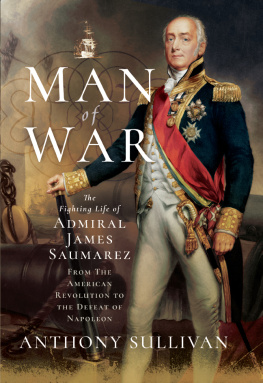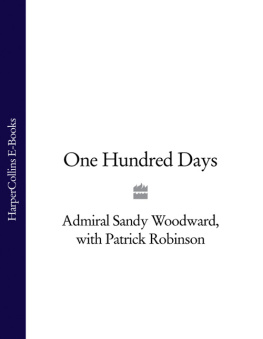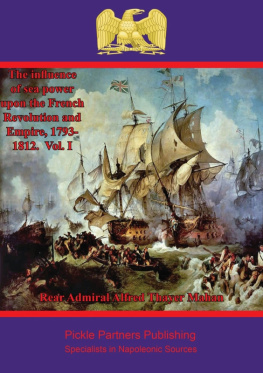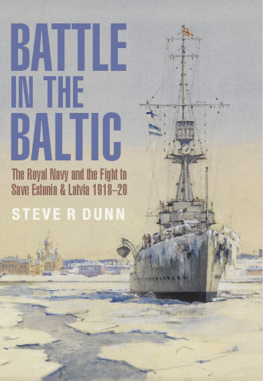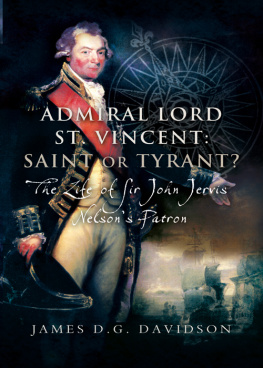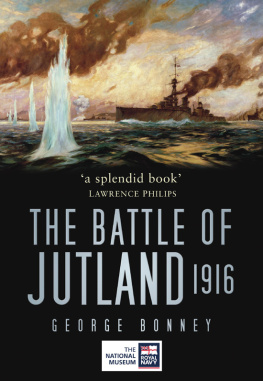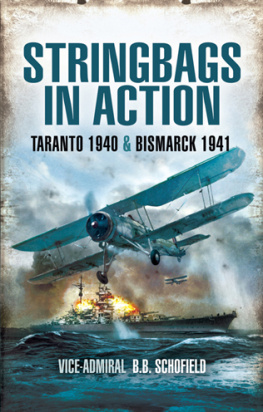
MAN
of
WAR
MAN
of
WAR
The Fighting Life Of
ADMIRAL JAMES SAUMAREZ
from the American Revolution to the Defeat of Napoleon
Anthony Sullivan
MAN OF WAR
The Fighting Life of Admiral James Saumarez,
from the American Revolution to the Defeat of Napoleon
This edition published in 2017 by Frontline Books,
an imprint of Pen & Sword Books Ltd,
47 Church Street, Barnsley, S. Yorkshire, S70 2AS
Copyright Anthony Sullivan, 2017
The right of Anthony Sullivan to be identified as the author of this work has been asserted by him in accordance with the Copyright, Designs and Patents Act 1988.
ISBN: 978-1-52670-651-5
eISBN: 978-1-52670-653-9
Mobi ISBN: 978-1-52670-652-2
All rights reserved. No part of this publication may be reproduced, stored in or introduced into a retrieval system, or transmitted, in any form, or by any means (electronic, mechanical, photocopying, recording or otherwise) without the prior written permission of the publisher. Any person who does any unauthorized act in relation to this publication may be liable to criminal prosecution and civil claims for damages.
CIP data records for this title are available from the British Library
For more information on our books, please visit
www.frontline-books.com
email
or write to us at the above address.
List of Maps
Rhode Island, America
The Battle of Dogger Bank, 5 August 1781
The Lesser Antilles
The Battle of the Saintes, 12 April 1782
Crescent versus Reunion , 20 October 1793
The English Channel and Atlantic Coast of France
Escape of Crescent , 8 June 1794
The Battle of Cape St Vincent, 14 February 1797
The Mediterranean in 1798
The Battle of the Nile, 1 August 1798
The Battle of Algeciras, 6 July 1801
The Baltic in 1808
Acknowledgements
I would like to thank the staff of the National Archives, Kew, the staff of the Ipswich branch of the Suffolk Records Office and the Societe Guernesiaise for their help in the preparation of this book. I would also like to acknowledge the work carried out by the Navy Records Society and thank the staff of the British Newspaper Archive, whose efforts in digitising over 200 years of British news history helped piece together the details of Saumarezs life not covered in his personal papers, Admiralty archives or Sir John Rosss original biography. At Frontline Books I would like to thank Martin Mace, John Grehan, and Stephen Chumbley. Finally I would like to offer my thanks to Paul Killick for his advice and support during the writing of this book.
Prologue:
Gibraltar 12 July 1801
S tung by their unexpected defeat and the loss of one of their ships in battle against the French on 6 July 1801 the British sailors had worked tirelessly for five days and nights to repair their badly damaged ships. Hulls were patched up, rigging replaced and masts and spars repaired. Several British ships were still taking on ammunition when the French squadron across the waters at Algeciras was spotted preparing for sea on the morning of 12 July and it was not until that afternoon, two hours after the enemy had left port, that the British ships were finally ready to put to sea. Passing a harbour wall lined with cheering spectators, a band on shore playing Britons Strike Home, the squadron headed out into the Bay of Gibraltar in line ahead, the 80-gun flagship Caesar leading the 74s Venerable , Superb , Spencer and Audacious into battle. Off Europa Point a small boat with two men aboard dressed in white hospital gowns was observed pulling towards the squadron. As the boat drew up alongside the flagship it became clear that the two men were members of Caesar s crew who been wounded in the earlier battle and had been convalescing in hospital. Seeing the squadron preparing to put to sea they had asked permission to rejoin their ship. When this had been refused they had escaped from the hospital, found a boat and rowed out to Caesar in order to fight alongside their crewmates.
Aboard his flagship the British admiral was anxious. Having lost the previous battle through a flaw in the wind which had frustrated his attack and left one ship aground and in enemy hands, Sir James Saumarez was eager for a victory to restore both British honour and his own reputation. However, the French squadron that he had fought across the Bay of Gibraltar in Algeciras on 6 July had been strengthened with the arrival of several Spanish ships including two First Rates of 112 guns each, Real Carlos and Hermenegildo . Whilst seriously outgunned, Saumarez had the utmost faith in the abilities of his officers and men and felt sure that victory would soon belong to the British. However, it immediately became clear that his hastily-repaired and poorly-sailing ships would soon lose contact with the faster-sailing enemy. Thankfully the British had one undamaged ship that had missed the previous battle, having been out on patrol, and Saumarez now ordered Superb to give chase to the enemy. Hoisting more sail Captain Keats ship soon disappeared into the night, her stern lights concealed in match tubs, her other lights shaded.
At 11.00pm, as Keats was walking the quarterdeck along with his surgeon, Benjamin Outram, the massive Spanish three-decker Real Carlos suddenly appeared out of the darkness on Superb s larboard bow, lights shining brightly from her gunports and cabin windows. Moments later Hermenegildo was sighted a little ahead of her compatriot. As Superb drew alongside Real Carlos Outram was ordered to his station below decks. At a range of around 300 yards Keats hauled up the foresail, took in the top gallant sails and unleashed the first of three broadsides with his larboard guns against the much larger Spanish ship. The third broadside brought Real Carlos s fore topmast crashing down and as the sail touched the forecastle guns their flashes set it alight, the flames raced up and along Real Carlos s rigging and she was soon ablaze both fore and aft. Observing that the Spanish ship was now on fire, Keats left her to her fate and headed off in pursuit of the French ship St Antoine , trailing at the rear of the combined squadron. Neither the Spanish nor the British had any distinguishing lights and in the confusion Real Carlos s crew had begun firing blindly in all directions, missing Superb but hitting the other Spanish three-decker Hermenegildo , which immediately returned fire. Her crew distracted by the fire now devouring their ship, Real Carlos soon ran into Hermenegildo which she also set on fire.
Watching the battle from his flagship Saumarez could see the flames engulfing the two Spanish First Rates, illuminating their colours, the sea around the two ships glowing red. In that instant he knew a British victory had been secured.
By the time Superb had forced the surrender of St Antoine the rest of Saumarezs squadron had caught up with Keats ship and were finally able to join in the action, pursuing the enemy as they attempted to sail back to Cadiz. Just after midnight the flames spreading through Real Carlos reached her magazine and she blew up. Hermenegildo was destroyed in a similar fashion some fifteen minutes later. The light from these two huge explosions, which had killed almost 2,000 Spanish sailors, was visible in Gibraltar and their effects could be felt as far away as Cadiz. Caesar was soon enveloped in a cloud of thick, acrid smoke that lay on the surface of the water and quickly spread throughout the ship, alarming some of her crew who mistakenly believed that their own ship was on fire.
Next page
